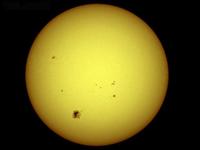Solar Cycles and Human Disease

We have all heard about the supposed association between full moon and mental illness, though most of the research has failed to find an association between phases of the moon and mood disorders or psychosis.
But something that we have not heard so much about is the possible association between solar activity and human problems.
Investigators from Chile presented some interesting data (NR308) at the 2007 Annual Meeting of the American Psychiatric Association in San Diego last month.
They used a measure of solar activity called the Wolf number that is based on the number of sunspots. The sunspot cycles are usually between 9.5 and 11 years. They examined the clinical records of 1862 individuals who had been seen at a psychiatric clinic in Santiago over a sixteen-year period, which corresponded to one and a half solar cycles. They found that there was a big rise in admission for severe depression during years with low solar activity and a slight increase in the number of admission for mania during years of high solar activity.
This is not the first time that a connection has been found between the sun and human affairs.
The same authors published a paper in Spanish two years ago in which they also found that depression is more common when there is less solar activity and mania increases when there is more activity. They cannot say whether it is just light that is causing this or some other form of radiation.
Two researchers used the Maine Medicaid database to look at the relationship between solar cycles and human disease, and found that that radiation peaks in solar cycles and particularly in chaotic solar cycles (CSCs) are associated with a higher incidence of mental disorders. The same researchers had previously used the same database to suggest that CSCs produce more ultraviolet radiation and it is this that limits human longevity by causing chromosomal damage.
Interestingly, in 1993 two researchers also suggested a relationship between solar activity and longevity. They looked at the mean longevity of birth cohorts from 1740 to 1900 for United States of America (U.S.) Congressional Representatives exhibited oscillations that coincided with the 9- to 12-year sunspot cycle. They found that the mean longevities of these cohorts were 2-3 years longer during times of low sunspot activity than at peak activity. This phenomenon was confirmed in data from members of the House of Commons of the United Kingdom Parliament and from University of Cambridge alumni.
Researchers in Slovakia have suggested that there may be an association between solar radiation and cerebral strokes, though their data is a little difficult to interpret.
It is clear that the Heavens have more of an impact upon us than many scientists realized, and need to be factored into studies of human mood and behavior.






